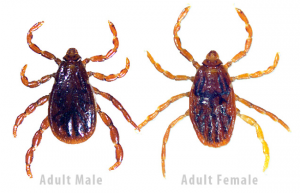I would like to provide our owners with a brief outline regarding aspects of Lyme disease in dogs. For the purpose of this discussion we will discuss the scenario of a dog coming to a clinic with either a tick attached or the history of a recent bite. Lyme disease is transmitted through a tick bite from a Black-Legged tick (otherwise known as a deer tick, identifiable by a small black spot on the back). There are studies in mice that indicate transmission is typically after 48-72 hours of feeding, although there may be some transmission earlier. This has to do with activation of the bacteria in the tick’s gut and regurgitation back into the host once engorged which takes some time. Owners need to keep in mind that the nymph life stage of the tick (which is roughly the size of a sesame seed) can also carry Lyme, so if one adult tick is seen there is always risk for exposure to others.
Our most recent studies suggest that Lyme is present in roughly 10% of ticks in the Rouge Valley, although the number is likely increasing. Dogs are relatively resistant to the disease and less than one in five (and perhaps as low as one in twenty) bitten by a Lyme burdened tick will get the disease. We have a very useful blood test to determine if a dog has been exposed by detecting antibodies against Lyme. The immune response typically takes 4 weeks so we usually delay testing until 4 weeks after the tick bite in a healthy dog.
Health Canada used to offer a free screening test on all ticks so that they could monitor incidence of Lyme in ticks and we used to send ticks to them by Purolator on a regular basis. The study they were performing has since come to an end – they have declared our region Lyme positive, so the cost is more significant. In addition, the turn-around time on the testing was 4 weeks, which is about the same time frame as the blood screen outlined above.
There is an excellent and extremely reliable overview of Lyme disease in dogs on the website for the Companion Animal Parasite Council. The general consensus is that prophylactic treatment with an antibiotic from a single tick bite is not recommended. You might wonder at this, but consider that proper treatment is a strong dose of Doxycycline for 30 days at least. At that dose dogs often develop upset stomachs and other gastrointestinal signs which can be really problematic, so treatment is not to be taken lightly.
In fact, even if there is evidence of exposure on our blood test, prophylactic treatment in the absence of any clinical signs is debatable, and some very well established institutions like the American College of Veterinary Internal Medicine DO NOT recommend treatment if the dog is asymptomatic (you’ll see this confirmed in the CAPC recommendations). Lyme disease causes two clinical scenarios in dogs. The first and most common is Lyme arthritis which results in a transient fever, lethargy and lameness (usually affecting one of the limbs). It usually responds quite quickly to a course of Doxycycline. The second (which is much rarer) is a protein-losing nephropathy that can eventually lead to kidney damage and failure. There are a significant number of dogs who demonstrate exposure to Lyme and never develop any signs whatsoever.
My feeling is that these recommendations make sense to me – I have done prophylactic treatments, but the dogs will often start losing appetite at the 2-3 week mark. In addition, it is difficult to gage efficacy – studies show that if Lyme nephritis is present there is a 15% chance it is not eliminated in one month and up to six months may be needed. I prefer to stick with the guidelines: treat seropositive dogs only if there is clinical evidence of lameness or evidence of protein loss in the urine.
So, for dog with a tick bite, our first step should be to determine if there has been exposure with the 4Dx test after 30 days. If that shows positive (one in ten chance), and there is no sign of lameness then we check the urine for evidence of protein loss. If that is normal then we take no action and periodically monitor the urine for protein loss every 3-6 months for the first year and every 6-12 after. If at any point he develops lameness and lethargy or protein loss in the urine then we start antibiotic therapy.
This may seem like a complex explanation, but it is a complex disease and it is not a simple treatment. The good news is that a dog bitten by a tick may not be exposed and even if he or she has been, the actual disease may never develop. If your dog is at risk for tick bites (i.e. there are deer in your area or where you walk) then you should still mitigate the risk of exposure by maintaining prevention: Advantix or Nexgard once monthly as long as the temperature is above 4oC. If you have any additional questions, please do not hesitate to call our clinic and speak with one of our staff members.
Written by Dr. Gawen Thompson



